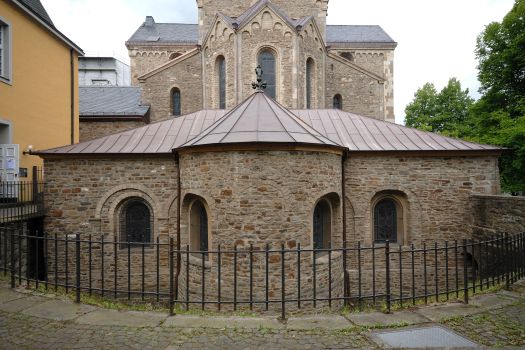
Christianisierung - Frühe Kirchen und Klöster
Das Kloster Werden gilt als eine Keimzelle für die Mission im rechtsrheinischen Rheinland und Westfalen. Der damals fremdartige christliche Glaube, verbunden mit unbekannten Bräuchen, neuartigen kirchlichen Strukturen und innovativen Bauformen, bewirkte in den bisher heidnisch geprägten westfälischen Gebieten letztlich eine neue religiöse und kulturelle Identitätsstiftung und Vereinheitlichung.
© Foto Roland Pieper
Glaube zurück zur Auswahl
Early churches and monasteries Unknown customs, new ecclesiastical structures, and innovative constructions
The chief significance of the period of Christianization by the Franks in the 8th and 9th centuries was the creation of an ecclesiastical structure in today’s Ruhr Region. Dioceses were created and monasteries, parishes and private churches were founded, which became the nuclei for spreading the Christian faith, but also for the consolidation of political and social power. The hitherto alien Christian faith, associated with unknown customs, new ecclesiastical structures and innovative structural shapes, contributed to the construction of a new religious and cultural identity and unity in what had up to now been pagan Westphalia.
The Werden monastery, which today belongs to the Essen municipal region, was one such missionary center in the Rhineland east of the Rhine, and in Westphalia. Liudger, appointed the first bishop of Münster in 805 founded a monastery here, and members of his family also held bishop’s seats. A network of monasteries and affiliations was thus created, which promoted the spread of Christian faith, and of the church structure. With the monastery now under royal patronage, the desire for representation also grew, and in the year 943, the western structure of the church was consecrated. The Werden Abbey also functioned as an educational institute for missionary work and priesthood, and was in this way the starting point for the Christianization of the Westphalian regions.
Nunneries and convents, coming into existence in great numbers, had a very similar function. The first phase of reestablishment can be placed between the 9th century and 1100. The Essen monastery also originates from this period, although the date 850 has not been verified. In the early Middle Ages, science and education was concentrated around monasteries. The convent played an important role in the cultural education of women, and the introduction of literacy, illustrated by the wonderful manuscripts preserved from the Essen scriptorium. The convent also had enormous political influence, after all, from the 13th century, the abbess of the Essen convent held a position in the realm as princess-abbess over a sovereign territory of the Empire.
One such convent was established in the 10th century Herdecke, which was a daughter church of St. Maria im Kapitol. The Herdecke convent church shows yet another type of foreign influence besides its function as an education centre, namely, the innovative architectural design of the church structure. During the first excavations in 1930s and 40s, the following picture emerged of the foundations: it was a three-nave pillar basilica with a triple apse attachment on the east side and a great hall on the west.
Another aspect in this context is the creation of original parishes and private churches. The 8th century saw the development of strict rules regulating church life. A ban on pagan rituals, and compulsory baptisms were introduced; church buildings were given emphasis as centres of religious everyday life. 120 court proprietors, one villain, a maidservant, and a tithe were due to each church with its clergymen. This led to the creation of parishes of fixed boundaries within the dioceses, the so-called "ancient parishes”.
Unna is regarded as one of the oldest ancient parish of Westphalia in the Cologne archdiocese. A decisive factor in its foundation was its location on the Hellweg, and it is assumed that Unna possessed a royal court established on the initiative of Charlemagne. It is also possible that within the royal court, the construction of a missionary and baptismal church was undertaken. No archaeological research has as yet been carried out on this church. Besides these organizational structures, private churches were another feature of great significance in Westphalia. The nobility built churches directly by their courts, oversaw their construction, and provided the priests who they appointed with land. Such private churches could also be starting points for the founding of denominations; an example for this is the private church with an immured churchyard in Bochum-Stiepel.
Denkmale zum Impuls
Essen - Abtei Werden
Die Abtei Werden begründete wesentliche Strukturen im heutigen Ruhrgebiet. Die ... weiter
Herdecke - Kanonissenstift
Die im 12. Jahrhundert erstmals archivalisch fassbare Benediktinerinnenabtei mit ihrer deutlich ... weiter
Bochum - Evangelische Kirche in Stiepel
Bereits im frühen 11. Jahrhundert wurde auf Drängen der hochadligen Emma aus dem ... weiter
Essen - Münsterkirche
Die ehemalige Stiftskirche und der heutige Dom des Bistums Essen SS. Cosmas und Damian steht im ... weiter
